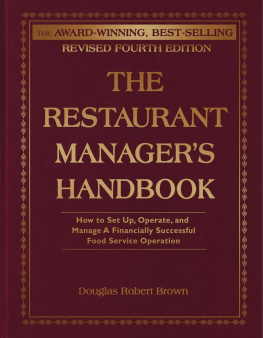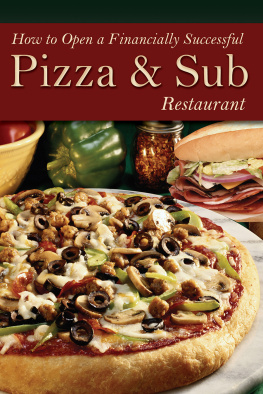How to Open a Financially Successful
Specialty Retail & Gourmet Foods Shop

Sharon Fullen and Douglas R. Brown
How to Open a Financially Successful Specialty Retail & Gourmet Foods Shop
Copyright 2004 Atlantic Publishing Group, Inc.
1210 SW 23rd Place Ocala, Florida 34471
Phone 800-814-1132 Fax 352-622-1875
Website:
SAN Number: 268-1250
No part of this publication may be reproduced, stored in a retrieval system, or transmitted in any form or by any means, electronic, mechanical, photocopying, recording, scanning, or otherwise, except as permitted under Section 107 or 108 of the 1976 United States Copyright Act, without the prior written permission of the Publisher. Requests to the Publisher for permission should be sent to Atlantic Publishing Group, Inc., 1210 SW 23rd Place, Ocala, Florida 34471
SAN Number :268-1250
Library of Congress Cataloging-in-Publication Data
Brown, Douglas Robert, 1960
How to open a financially successful specialty retail & gourmet foods shop / by Douglas Robert Brown.
p. cm.
ISBN 0-910627-32-0 (alk. paper)
1. New business enterprises. 2. New business enterprises--Management. 3. Food industry and trade. 4. Specialty stores. I. Title.
HD62.5.B7623 2004
381.45641300681--dc22
2004008414
LIMIT OF LIABILITY/DISCLAIMER OF WARRANTY: The publisher and the author make no representations or warranties with respect to the accuracy or completeness of the contents of this work and specifically disclaim all warranties, including without limitation warranties of fitness for a particular purpose. No warranty may be created or extended by sales or promotional materials. The advice and strategies contained herein may not be suitable for every situation. This work is sold with the understanding that the publisher is not engaged in rendering legal, accounting, or other professional services. If professional assistance is required, the services of a competent professional should be sought. Neither the publisher nor the author shall be liable for damages arising herefrom. The fact that an organization or website is referred to in this work as a citation and/or a potential source of further information does not mean that the author or the publisher endorses the information the organization or website may provide or recommendations it may make. Further, readers should be aware that Internet websites listed in this work may have changed or disappeared between when this work was written and when it is read.
TRADEMARK DISCLAIMER: All trademarks, trade names, or logos mentioned or used are the property of their respective owners and are used only to directly describe the products being provided. Every effort has been made to properly capitalize, punctuate, identify, and attribute trademarks and trade names to their respective owners, including the use of and wherever possible and practical. Atlantic Publishing Group, Inc. is not a partner, affiliate, or licensee with the holders of said trademarks.

Chapter 1: Starting Your Own Gourmet Store
The specialty (or gourmet) food industry continues to grow at a steady pace regardless of the state of the economy. In fact, budget-trimming for some folks means dining out less and creating gourmet meals at home instead. This shift of dollars means business opportunities for you!
Operating an independent retail store is hard work. Your success depends upon your entrepreneurial skills along with excellent research. Realizing your dream can be an exceptionally rewarding endeavorpersonally and professionally. The ingredients for success go well beyond an elegantly appointed store or the best names in cutlery; they are a complex blend of passion, vision, risk-taking and business acumen.
Solidifying Your Vision
Your dream of owning your own business sparks your quest, but creating a solid vision of how you want to accomplish your dream is the foundation of success. Creating a vision will help you write your business plan, sell your concept to lenders and potential investors, and communicate your desires and needs to architects, contractors, designers and suppliers.
To follow are some ways to help you solidify your vision. This understanding will help you make decisions when faced with compromises, budgetary problems and unforeseen obstacles.
Ways to Explore Your Passion
Close your eyes. Can you see your dream operation? Are the glass displays filled with artfully arranged cooking utensils? Do regulars come in just to see what is new? Do people enjoy tasting your samples? These images all represent your passion.
Take a few hours of uninterrupted time to think over your personal and financial reasons for committing your energies and nest egg, taking on a partner or tying yourself to a long-term loan. It takes time to become profitableare you prepared financially and emotionally for this investment?
Create a list of the positives and negatives of being in business for yourself. Every venture has risk (negatives), but the positives should outweigh them. If your entrepreneurial spirit is not dampened by the potential risks, your next step is to give your vision a voice.
Determine what talents you can bring to the process. Do you love searching for exciting new food products, or are you more interested in selling? Do you want to let hired design professionals handle the details, or do you prefer to be consulted on every detail from the front door to the receiving door?
What Do You Want Your Store to Be?
Since you are reading this book, we can assume that you are a foodiesomeone who reads cookbooks, enjoys trying new restaurants, has all the latest cooking gadgets or travels 85 miles round trip for the perfect loaf of French bread. In other wordsyou have the passion!
Now turn your thoughts to selling your passion. What do you want to sell and how will you go about it? Retail stores come in many different sizes, shapes and styles, and there are thousands of choices on what you could stock and how you could present it.
Before you can start developing your business and marketing plans (see Chapter 5), you need to sit down and write a thorough description of what your store will look like, what kinds of products you will carry and who will want to buy these products. Every decision from this day forward will be based upon that definition. However, because this definition is based upon assumptions and unknowns, you will be redefining and fine-tuning it along the way. If you do not revise this definition, it probably means that you have not thoroughly researched your business prospects and customer needs.
Remember, this is a definition from the heartnot based on research at this point. When you close your eyes, can you mentally walk up and down the aisle and see what your customers will see?
Write a one-minute elevator pitch. If you found yourself in an elevator with a wealthy investor, how would you describe your vision (and secure the cash) in the time it takes to travel up 20 floors? Show your passion while emphasizing the tangible benefits.
Your Store Could Be
Imagine what your store will look likethis is called merchandising. How you merchandise your products directly affects the crowd you attract, creates perceived values of your wares and increases your sales per customer visit.







